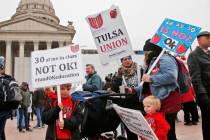Prices dip nationally, Las Vegas sees big hitTHE HOUSING SCENE
WASHINGTON -- The first government housing-price numbers are in, and they're not pretty. But the figures certainly aren't as bad as other surveys make them out to be.
According to the Federal Housing Finance Board's quarterly survey of the country's 32 largest metropolitan areas, the average price of both new and resale houses dipped 1.4 percent in the first quarter. That's the first decline recorded by the FHFB in decades.
Let's take a deeper look into the housing finance board's first-quarter findings:
Of the 32 markets covered, 18 reported declining prices. Most of the 14 that recorded higher prices are located in the nation's heartland and did not take part in the buying frenzy that caused prices to soar in many big coastal markets.
One poster-boy market for excessive prices -- prices driven up in large part by investors who were trying to may a quick buck by turning over their house shortly after buying them -- showed a big drop. That would be Las Vegas, where the average fell 9.4 percent, from $350,200 to $317,400.
Numerically, the national average when the first quarter ended March 31 was $318,000, down from $322,400 at the same time a year earlier. But it's a modest decline compared to what other price surveys will soon report.
One reason the housing finance board's figures tend to be higher than those of other studies is that it includes new homes. Despite the giveaways and other come-ons used by builders these days to reduce standing inventories, new homes still lead when it comes to setting the price pace.
Another factor is that the survey covers the entire range of home sales, not just those with a mortgage at or below $417,000.
Coincidentally, the finance board's price survey is used to set the limit, also known as the conforming loan ceiling, on the loans Fannie and Freddie can purchase or roll into securities for sale to investors worldwide. But unlike the housing price survey conducted by the Office of Federal Housing Enterprise Oversight, the agency that regulates the two government-sponsored companies, the finance board's count is not limited to loans touched by Fannie and Freddie.
Another key distinction is that the finance board's survey covers a wider swath because it includes sales made with loans from all types of lenders. It is not limited to sales that involve Fannie Mae and Freddie Mac, which now touch, in one way or another, less than 50 percent of all mortgages.
It also isn't limited to houses that are sold through multiple-listing services. A good many, but certainly not all, existing homes are sold through an MLS affiliated with the National Association of Realtors.
And finally, the housing finance board's research covers metropolitan areas as opposed to regions of the country, even if the metro areas viewed are only the largest ones.
The only drawback to the survey is that houses sold with government loans don't count. Houses bought by families who turn to loans insured by the Federal Housing Administration or guaranteed by the Department of Veterans Affairs tend to be priced lower than those sold with conventional loans, so the finance board's prices skew somewhat higher than those in other surveys.
Lew Sichelman has been covering real estate for more than 30 years. He is a regular contributor to numerous shelter magazines and housing and housing finance industry publications.









